Where to dig in?
You’ll need the best gardening tools like protective gloves, a sturdy trowel for transplanting, and a hand rake for debris removal to start your gardening journey. Invest in quality pruning tools including bypass pruners for live branches and anvil pruners for dead wood. Don’t overlook soil preparation equipment like garden forks for aeration and spades for thorough digging. Consider transport solutions such as portable toolboxes and wall-mounted storage to keep everything organized and accessible for maximum efficiency.
Essential Hand Tools Every Gardener Needs
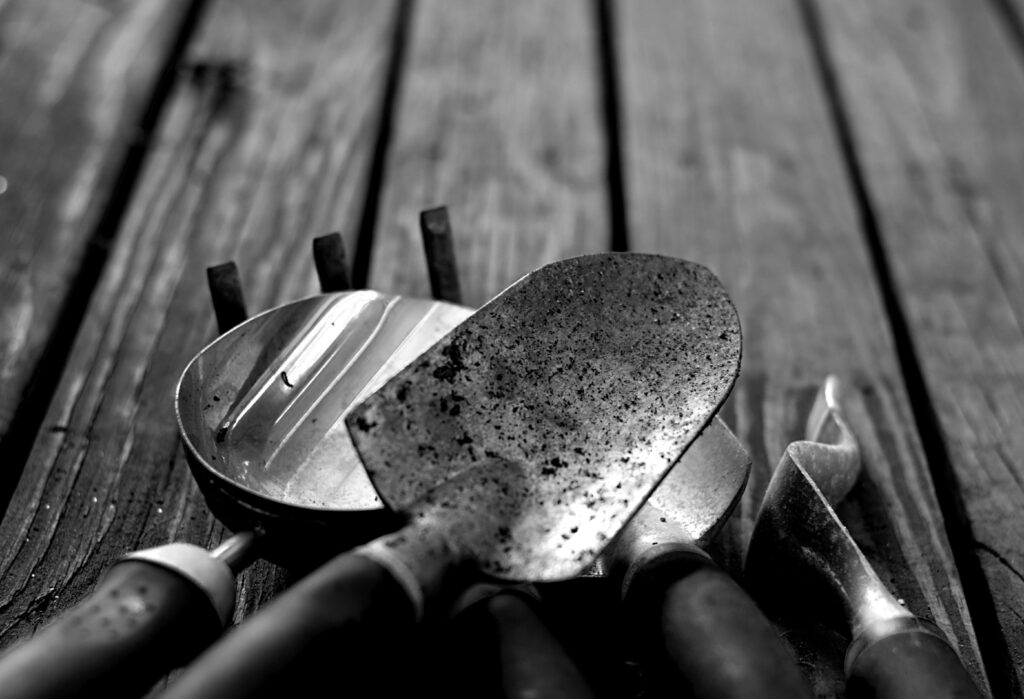
Success in gardening starts with having the right hand tools at your fingertips. You’ll want to invest in five essential tools that’ll handle most basic garden tasks effectively. Protective gloves should be your first purchase, shielding your hands from thorns, dirt, and potential cuts. Choose gloves that provide a comfortable fit and are suitable for the specific gardening tasks you plan to perform. A hand trowel comes next, perfect for transplanting seedlings and removing stubborn weeds from tight spaces.
Having quality hand tools within reach is the cornerstone of every thriving garden and successful growing season.
Your hand rake will keep garden beds tidy by clearing fallen leaves and debris efficiently. The hand cultivator serves multiple purposes, loosening compacted soil around plants and eliminating weeds simultaneously. When using your hand cultivator, maintain a firm grip on the handle to prevent wrist strain during extended use.
Finally, a hoe rounds out your collection, making quick work of weeding larger areas and cultivating soil between rows. These five tools form the foundation of any successful gardener’s toolkit.
Pruning and Cutting Tools for Plant Health
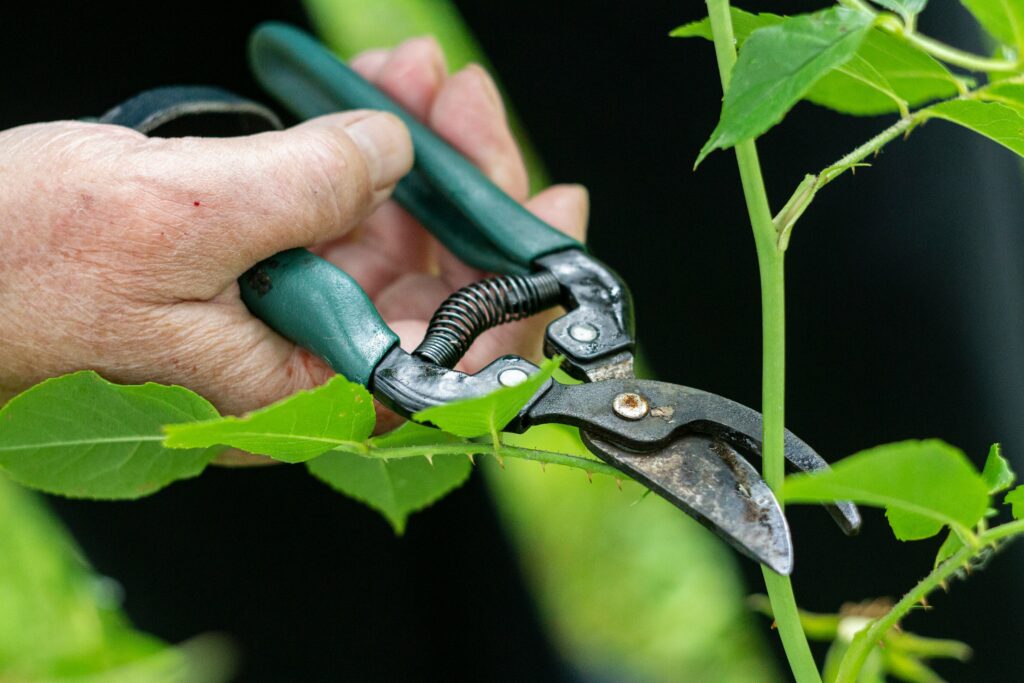
While basic hand tools handle most garden maintenance, proper plant care requires specialized cutting equipment designed for different pruning situations.
Pruning Shears for Everyday Tasks
You’ll need bypass pruners for live stems and branches, as they create clean cuts that promote healthy plant growth. Choose anvil pruners for dead wood or thicker branches, since their single blade design handles tougher materials. Look for carbon steel blades with rust-resistant coatings like titanium, and select ergonomic grips to reduce hand fatigue. An exceptional choice for both live and dead wood cutting is the Kent and Stowe Eversharp Bypass Secateurs, known for its durable handles and a long-lasting blade coating.
Loppers and Saws for Larger Jobs
Loppers extend your reach for thicker branches without requiring ladders, while pruning saws tackle the heaviest cutting tasks. Curved blades work best for thick branches, straight blades for precise cuts in tight spaces. Garden snips handle delicate work like trimming herbs and flowers with precision control. For optimal hedge maintenance, hedge shears excel at shaping hedges, small shrubs, and evergreens while also performing well for deadheading perennials.
Soil Preparation Equipment for Better Growing Conditions
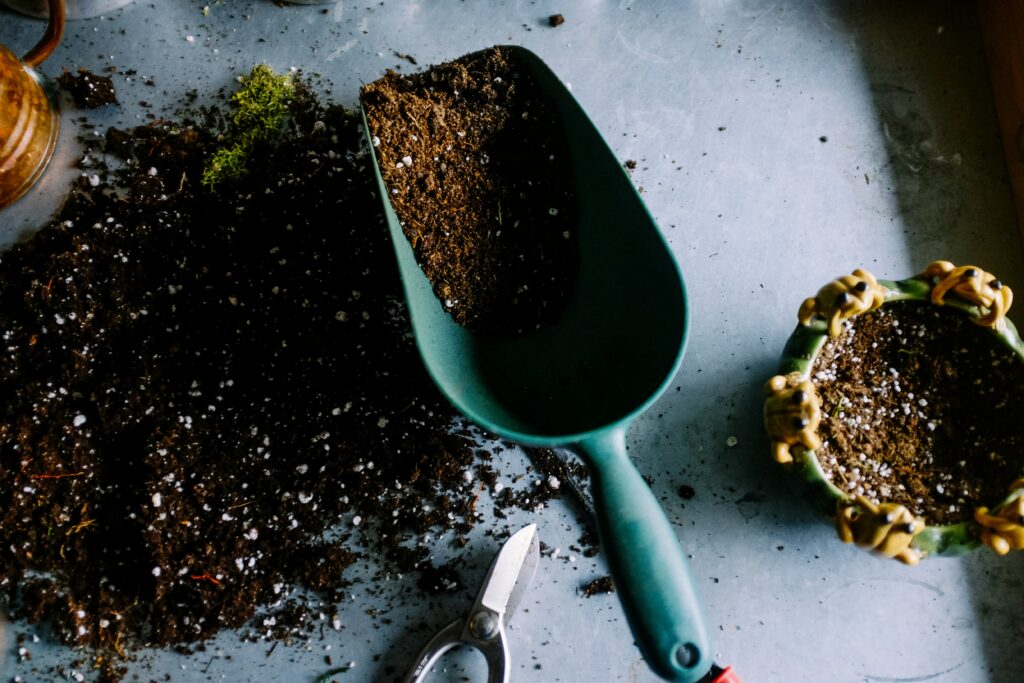
Before you can plant anything successfully, you’ll need the right soil preparation equipment to create the ideal growing environment for your plants.
Essential Digging Tools
Start with a garden fork to break up clumps and improve soil aeration. You’ll use a spade for thorough digging, while a shovel helps move loose soil around your garden beds. Ensuring proper drainage is vital, particularly if you’re dealing with sandy or silty soil types.
Surface Preparation Equipment
A hoe removes weeds that compete for nutrients, and a cultivator loosens topsoil for mixing amendments. Use a rake to level and spread soil evenly across your beds. Garden hoes are also excellent for creating furrows for planting seeds in prepared beds.
Material Transport
You’ll need a wheelbarrow or garden cart to move heavy loads of soil, compost, and plants without straining your back.
Don’t forget protective gear like garden gloves and knee pads for safer, more comfortable work sessions.
Digging and Planting Tools for Successful Cultivation
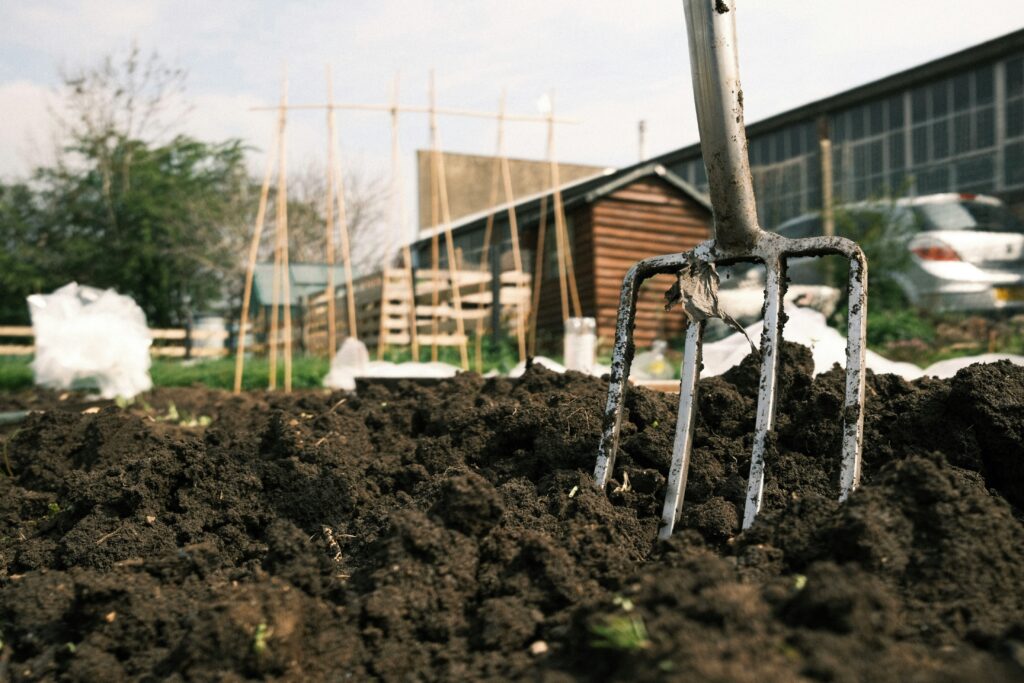
How do you turn a bare patch of soil into a thriving garden bed? You’ll need the right digging and planting tools to break ground effectively, prepare soil properly, and establish healthy plants.
Essential Digging Tools
Spades cut through soil and roots cleanly, making them perfect for edging garden beds and digging planting holes. Garden forks break up dense, compacted soil while aerating it naturally. For smaller tasks, trowels excel at transplanting seedlings and creating precise planting holes. The DeWit Forged Hand Fork is highly recommended for its sturdy construction, suitable for small gardens with boron steel tines.
Specialized Equipment
Hori hori knives combine cutting and measuring functions, featuring serrated edges and depth markings. Augers drill through rocky, hard ground effortlessly. Post hole diggers create deep holes for trees and fence posts. Select tools with ergonomic handles to reduce strain during extended use.
Choose tools based on your soil type—rocky ground requires sturdy augers, while clay soil benefits from garden forks.
Transport and Storage Solutions for Garden Organization
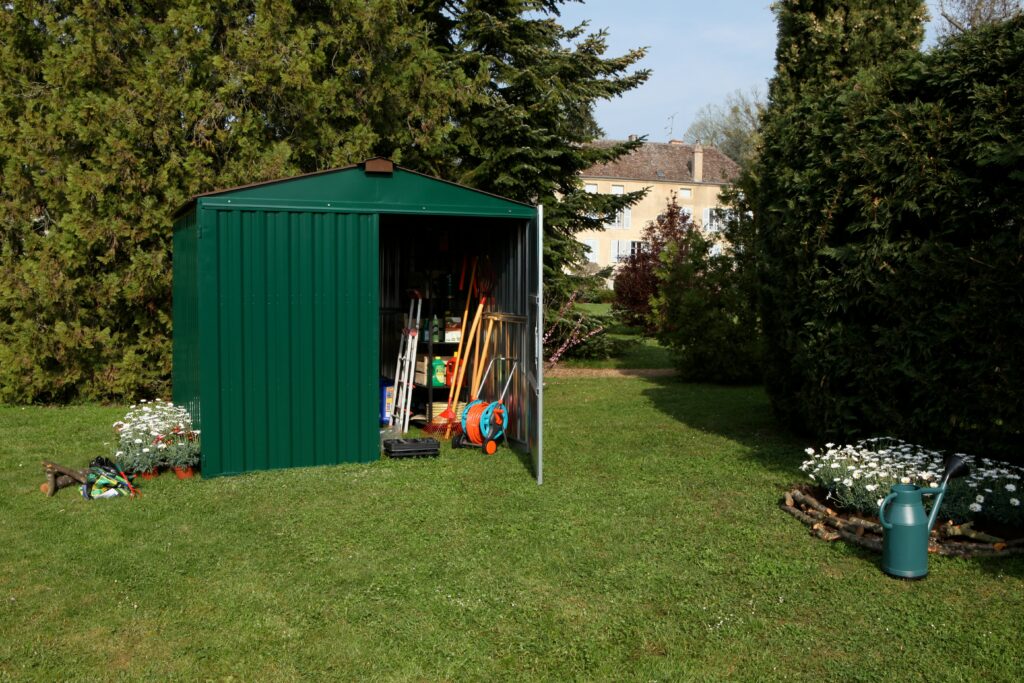
Once you’ve gathered all the right tools for digging and planting, you’ll need smart ways to move them around your garden and store them safely.
Portable Storage Options
Portable toolboxes offer excellent mobility, letting you carry essential tools between garden beds effortlessly. These lightweight caddies feature organized compartments that keep small tools separate, and many include lockable lids for security. The portable toolboxes segment is experiencing strong growth as more gardeners seek convenient mobility solutions for their outdoor projects. For those seeking highly durable garden hoses to pair with their storage solutions, consider the Flexzilla Hose praised for its kink-resistant design.
Garage Organization Systems
Your garage provides ideal protection from weather while keeping tools centralized. Wall-mounted pegboards maximize vertical space for hanging tools, while custom shelving creates designated zones for supplies. Overhead storage works perfectly for seasonal equipment you don’t use regularly.
Smart Features to Contemplate
Look for modular systems with removable trays that adapt to your specific tools. Integrated lighting helps you find items in dim spaces, while corrosion-resistant materials guarantee long-lasting durability in outdoor conditions.
Specialty Tools for Specific Gardening Tasks
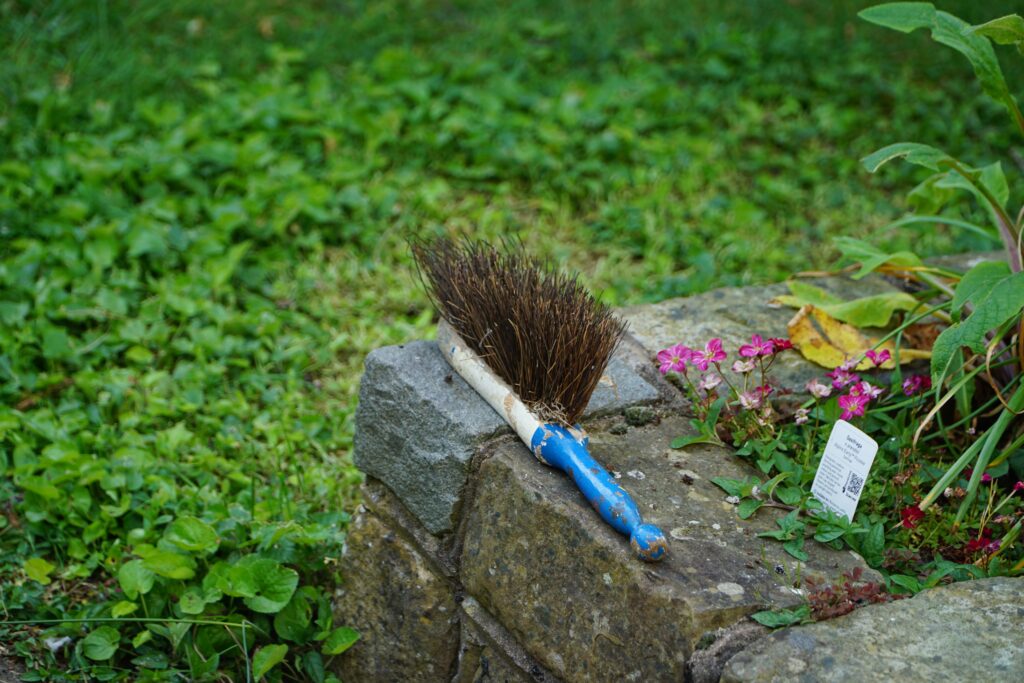
While basic storage keeps your fundamental gardening equipment organized and accessible, specialized tools take your gardening skills to the next level by targeting specific tasks with precision and efficiency. Cultivating blooms can be enhanced by understanding techniques from Floret Farm’s Cut Flower Garden.
Essential Specialty Tool Categories
You’ll find that specialty tools fall into five main categories, each designed for specific gardening challenges. These tools help you work smarter, not harder, while achieving professional results in your garden. Quality construction features like forged aluminum handles with ergonomic designs reduce hand fatigue during extended use.
| Tool Category | Primary Function | Key Benefit |
|---|---|---|
| Pruning Tools | Cut branches and stems | Clean, precise cuts |
| Weeding Tools | Remove unwanted plants | Target specific weeds |
| Digging Tools | Break ground and move soil | Reduce physical strain |
| Planting Tools | Start seeds and transplants | Improve success rates |
| Soil Preparation | Ready beds for planting | Create ideal growing conditions |
Irrigation Equipment for Proper Plant Watering
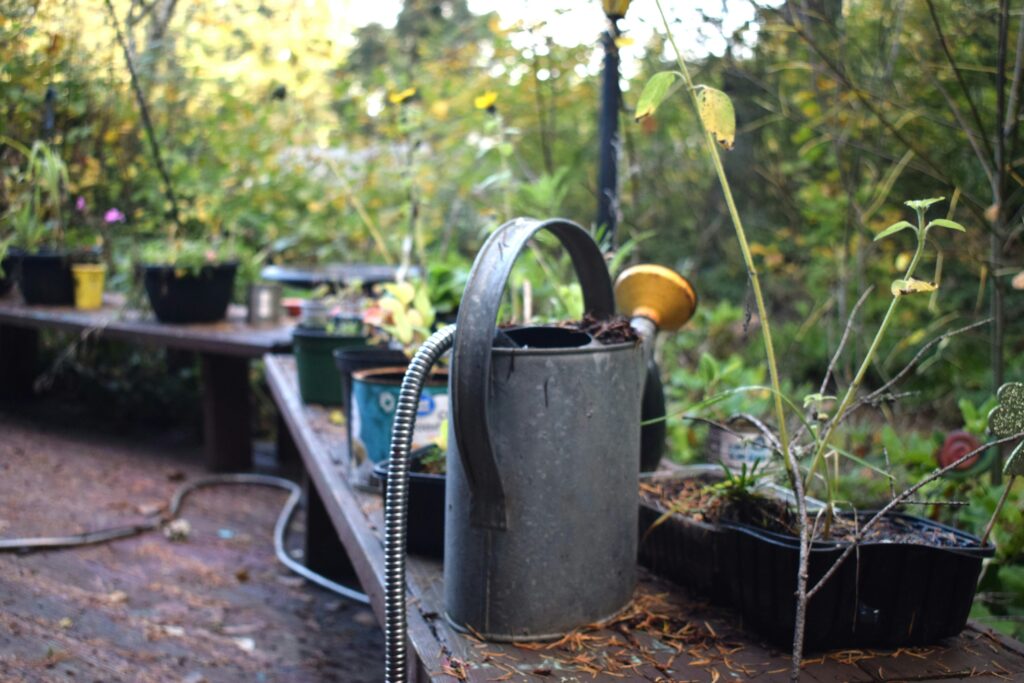
Efficient watering transforms your garden from surviving to thriving, and choosing the right irrigation equipment makes all the difference in your plants’ health and growth. Each system offers unique benefits that’ll match your garden’s specific needs, budget, and layout.
Soaker hoses deliver water directly to soil through tiny pores, preventing disease while minimizing waste—perfect for beginners and raised beds.
Drip systems provide precise water delivery to individual plants, promoting healthy root growth through consistent moisture levels.
Sprinkler systems offer cost-effective coverage for larger areas, with various types available for different garden layouts and sizes. Using durable hoses, such as the Teknor Apex Zero-G, enhances your irrigation system by providing flexibility, resistance to kinking, and reliable water flow.
Automated systems use smart sensors and programmable timers, reducing manual labor while optimizing watering schedules for maximum efficiency. Gardens on sloped terrain benefit from specialized irrigation planning since terrain slope affects water runoff and distribution patterns.
Tool Maintenance and Care for Longevity
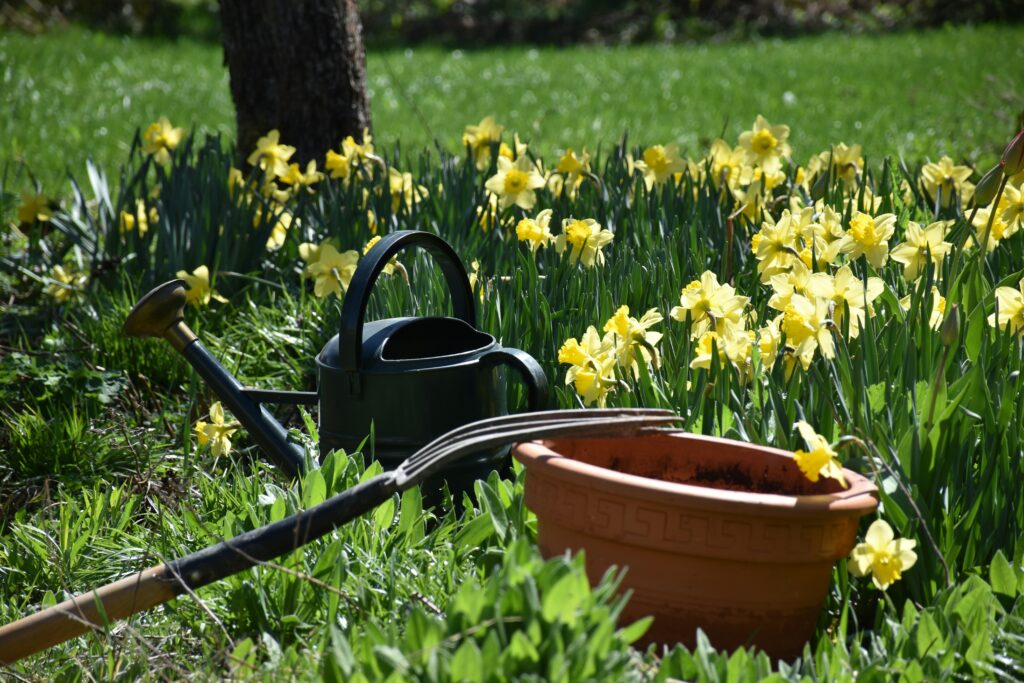
Proper tool maintenance consistently transforms expensive gardening equipment from short-term purchases into lifelong investments that’ll serve your garden for decades. Daily inspections after each use help you catch damage early, preventing costly replacements down the road. Milwaukee and Ryobi are among the top gardening tool brands where you can purchase durable and efficient tools.
A few minutes of daily tool care prevents hundreds of dollars in premature equipment replacement costs.
Essential Cleaning Steps
- Wipe tools clean with a damp rag after every use
- Rinse digging tools thoroughly to remove soil and debris
- Dry completely to prevent rust formation
- Sanitize regularly using disinfectant, especially after handling diseased plants
Monthly Maintenance Tasks
- Sharpen blades to maintain effectiveness and reduce physical strain
- Apply oil to moving parts for smooth operation
- Check handles for cracks or weakness at seams
- Remove rust using sandpaper when necessary
Store tools in dry locations, organized on hanging racks or containers to prevent damage and corrosion. Label each tool with your name or color for easy identification and to prevent loss when working in community gardens or borrowing tools to neighbors.
Frequently Asked Questions
What’s the Average Cost to Start a Basic Gardening Tool Collection?
You’ll spend between $15 and $60 for a basic gardening tool collection, with most beginner sets costing $20 to $40. Essential tools include a hand trowel, garden fork, pruning shears, gloves, and watering equipment.
Stainless steel sets cost more but last longer without rusting. Educational sets run $46 to $62, while standard 4-6 piece collections offer the best value for starting gardeners.
Which Tools Should Left-Handed Gardeners Choose for Better Comfort and Efficiency?
You’ll want left-handed pruning shears for precise cuts, angled hoes for better soil leverage, and specialized weeding tools for root removal. Choose ergonomic handles that reduce strain, rotating blade features for efficiency, and utility knives designed for your grip.
Consider Japanese flower scissors for delicate work, Italian pruners for heavy tasks. Shop at Lefty’s Store, Garden Tool Co., or Hidari for quality options.
Are Ergonomic Gardening Tools Worth the Extra Investment for Occasional Gardeners?
You’ll find ergonomic gardening tools worthwhile despite the higher upfront cost. They prevent injuries like back strain, tendonitis, and blisters that could lead to expensive medical bills.
Since you garden occasionally, you’ll appreciate the reduced fatigue and increased comfort during longer sessions. These tools last longer due to durable materials, eliminating frequent replacements. You’ll work more efficiently, saving time and energy while extending your gardening years.
What Tools Work Best for Container Gardening on Balconies or Patios?
You’ll need compact, multi-purpose tools for balcony gardening success. Start with a two-gallon watering can, mini hand trowel, and pruning shears for basic maintenance.
Add self-watering containers and vertical planters to maximize your space efficiently. Don’t forget moisture meters to prevent overwatering, quality potting mix with good drainage, and stackable planters.
These tools help you create a thriving container garden in limited space.
Which Gardening Tools Can Children Safely Use When Learning to Garden?
Start toddlers with lightweight plastic watering cans and soft-handled mini trowels that fit small hands comfortably.
Preschoolers can safely use metal-tipped plastic tools, child-sized garden forks with rubber grips, and basic pruning scissors with safety locks. Choose tools with rounded edges, BPA-free materials, and ergonomic designs.
You’ll want adjustable gloves, collapsible rakes, and sturdy buckets with comfortable handles for successful gardening experiences.
Conclusion
You’ve learned about the essential tools that’ll make your gardening journey more productive and enjoyable. Start with basic hand tools, then gradually add specialized equipment as your needs grow. Remember, quality tools maintained properly will serve you for years. Invest in durable pieces, clean them after each use, and store them correctly. With the right tools in hand, you’re ready to create the thriving garden you’ve always wanted.

